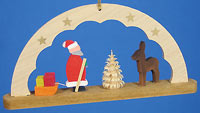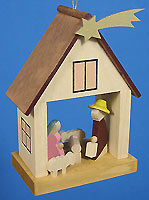Erzgebirge Germany – Home to Christmas ornaments
Erzgebirge Germany – Home to Christmas ornaments
The Erzgebirge Regions of Germany is full of life, culture and traditions. This area claims to be the birthplace of many Christmas customs and icons, like the Christmas tree and Christmas ornaments, as well as many traditional Christmas gifts like candle carousels, pyramids, nutcrackers, figurines and smokers. These crafts like the region, are unique, enchanted and have a broad history.

The Erzgebirge Regions are characterized by a string of tree-covered mountains, which extends from Dresden and Saxony, Germany, to Tschechien, or Czech Republic. These mountains were rich in iron, tin and silver ore, giving the area a reputation for mining. A reputation, which can still be found in the many German smokers formed into the character of miners and in the Christmas arches that are made in this region. (The Christmas Arches are said to represent the entrance of a mine.) It is from these rich metal resources that the Erzgebirge Mountains have gained their nickname as the "Ore Mountains." Today, however, most of the mines in this region have closed and very little mining takes place. The residents of the area have become very protective of the resources around them, and rather than exploit the earth, have made the Ore Mountains into a tourist destination. Many small shops selling German crafts have been established in this region.
Historically, the Erzgebirge Regions were mostly uninhabited until the late Middle Ages, due to its dense forests and difficult terrain. The few peoples who did live in these mountains were Slavic trappers. When ores were first discovered here, mines were quickly established - during the 15th century. One of the most productive mines was located in the city of Marienberger, in Saxony. This mine sought silver ore. The mines faced difficulties without modern inventions. The pit created to access the vein of ore would also act as a cistern, storing rain and run-off water. This made mining a dangerous job - and one that would be impossible during the winter months.

These surface mines were stripped in the following centuries and the miners who lived here were forced to seek another source of revenue. They turned to what had previously been hobbies to keep the people occupied during the long winter months, where mining was not feasible before modern inventions. The region is now known for its extensive cottage industries and handcrafts ranging from woodworking and creating Christmas pyramids, little smoking men and nutcrackers to the creation of violins, silver jewelry, intricate embroidery (characteristic in much German Linen) and some stone work. The most common craft medium is wood, which is plentiful in the mountains and a renewable resource. Originally, these cottage industries were home ventures. Each family would have a specialty, example the Mueller Family was known for the arches and German pyramids that they designed with multiple levels, while the Gläesser family was renowned for their whimsical characters in the smokers and nutcrackers they created. In time, however, these companies expanded beyond their homes to become small family-run factories or groups of workers. In spite of their growth, the individuality and uniqueness of these pieces remains.
The cottage industries found a market for the goods they created with the development of Christmas. During the Reformation, the winter holiday changed from Saint Nicholas Feast day, where small gifts were given, to Christmas (literally: Christ - mass) to celebrate the birth of the Christ Child. It was with this change that Christmas became associated with gift giving on a greater scale than the gift giving of Saint Nicolas Day, previously celebrated. To encourage the mass adoption and subsequent popularity for this new holiday, the protestant churches set up markets outside their churches during the period of Advent. These markets later were called, Christkindl-markets and were places where friends and family would gather, small and large.
